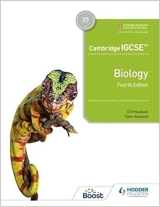Chapter 4. How substances get in and out of cells
Page 28
1. The cells on the left are in a region of high oxygen concentration and, initially there is little or no oxygen in the red cells. The concentration gradient favours the passage of oxygen into the cells. The cells on the right are in a region of a lower oxygen concentration than exists in the red cells. The diffusion gradient, therefore, favours the diffusion of oxygen out of the cells.
2. a Air freshly breathed in contains more oxygen that the red cells in the capillary. Oxygen will consequently diffuse into the cells. Red cells returning to the lungs contain higher concentrations of carbon dioxide than the air in the alveolus, so carbon dioxide diffuses out.
b If the blood flow increased, the exchange of oxygen and carbon dioxide would also increase.
3. Controlled diffusion, endo- and exocytosis, active transport
4. In air, the uptake of phosphate goes on at a steady rate for about 20 hours. In nitrogen, (i.e. in the absence of oxygen) the rate of uptake is very low. This result suggests that phosphate uptake is by active transport, a process which needs oxygen to generate the necessary energy.
Page 31
1. Water will diffuse from the 5 percent solution into the 10 percent solution.
2. The cell membrane in a living cell controls the movement of substances (in this case a red pigment) into or out of the cell. Boiling kills the cell by denaturing its enzymes, and the cell membrane loses its ability to control the loss of pigment.
3. If animal cells were studied in water, they would take up water by osmosis till they burst. The concentration of Ringer’s solution is the same as the cell’s cytoplasm so there is no osmosis.
4. The molecules (or ions) of the dissolved substance attract water molecules, leaving fewer ‘free’ water molecules in the solution. The accumulation of sugar in the plant cell will lower its water potential and it will absorb water by osmosis from its neighbours. This may harm the cell. Starch in the plastids is insoluble and so does not affect the cell’s water potential.
Page 34
1. a If a ‘stronger’ (more concentrated) solution was placed in to cellulose tube you would expect the rate of osmosis to increase. This would accelerate the rise of liquid in the capillary tube.
b So long as the solution in the beaker is weaker (less concentrated) than the solution in the cellulose tube, osmosis will still occur and the water column will rise but more slowly.
c If the sugar solution were in the beaker, water would leave the cellulose tube and the water column would go down.
2. Water would continue to enter the cellulose tube until it burst.
3. The explanation is given in the caption. When the cell is immersed in water, the water potential of the cell sap is lower than that of the water. So water will enter via the selectively permeable cell membrane and expand the vacuole till it fills the cell.
4. Put the starch solution in the beaker and the iodine solution in the cellulose tube. If the ‘in but not out’ theory is correct you would expect the starch solution in the cellulose tube to go blue and the iodine solution to remain brown. If the ‘molecular size’ theory is correct you would expect the starch solution to turn blue but not the iodine solution in the cellulose tube. (In practice this is what happens but since the blue colour first appears on the outside surface of the cellulose tube, it looks as if the tube contents have turned blue).
5 When the pressure of the water column equals the ‘osmotic pressure’ in the cellulose tube, the flow will cease. (‘Osmotic pressure’ is the difference between the water potentials of the sugar solution in the cellulose tube and the water surrounding it). |
Downloads
Download the answers in PDF format below
Section 1, Chapters 1-5
Section 2, Chapters 6-9
Section 3, Chapters 10-12
Section 3, Chapters 13-17
Section 3, Chapters 18-20
Section 4, Chapters 21-24
Section 5, Chapters 25-27
Section 5, Chapters 28-29
Section 6, Chapters 30-34
Section 6, Chapters 35-37
Section 7, Chapters 38-39
Section 8, Chapters 40-41
|
